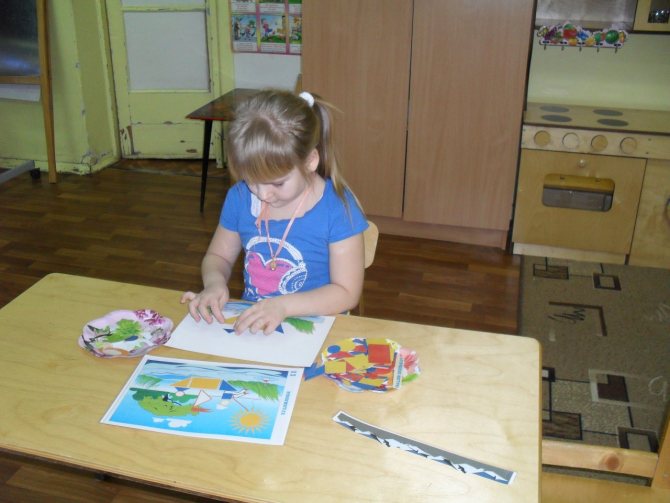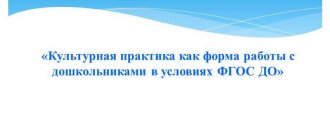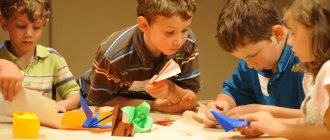TARGET SECTION
Explanatory note
Goals and objectives of the Program implementation
Determined in accordance with the Federal State Educational Standard of Educational Education, the Charter of the educational institution.
The goals of the Program are: creating conditions for the development of a child that open up opportunities for his positive socialization, his personal development, development of initiative and creativity based on cooperation with adults and peers and age-appropriate activities; creating a developmental educational environment, which is a system of conditions for socialization and individualization of children.
•Can be supplemented with the goals of correctional and developmental work
The objectives of the program implementation will be determined on the basis of clause 1.6 of the Federal State Educational Standard for preschool education:
•Can be supplemented in accordance with the goals of implementing partial educational programs and correctional and developmental programs (in accordance with the Charter)
Principles and approaches to the formation of the Program
•Formulated on the basis of Federal State Educational Standards DO clause 1.4.
•Can be supplemented by the principles and approaches of the author’s comprehensive educational program and partial educational programs, provided that they are consistent and lack duplication.
Characteristics significant for the development of the Program
The location of the preschool educational organization, the features of the building and the walking area, their influence on the organization of educational activities.
Characteristics of national and cultural characteristics and social environment that influence the organization of educational activities.
Information about groups operating in a preschool educational organization (number of functioning groups, occupancy, group orientation (general developmental, compensatory, health-improving or combined orientation), number of groups of different orientations)
Information about parents as participants in educational relations (characteristics of the well-being / disadvantage of families at the time of the creation of the program, educational requests of parents at the time of the creation of the program).
Characteristics of the developmental characteristics of children of early and preschool age (the main age-related psychological and pedagogical characteristics are indicated, their significance for the implementation of the Program)
Planned results of mastering the Program
1 design option.
Are specified in accordance with age groups based on the targets of the Federal State Educational Standard for Education.
2 design option.
They are specified in accordance with age groups based on the educational areas of the Federal State Educational Standard and taking into account the target guidelines of the Federal State Educational Standard for Education.
An example of an educational area is cognitive development.
Example. Social and communicative development (3-4 years)
- The child participates in joint activities with the teacher
- Agrees on joint activities with peers, enters into paired interactions regarding toys and play activities
- Maintains a predominant emotional and positive mood in kindergarten
- Emotionally responds to the pronounced emotional state of close adults and peers
- Uses forms of greeting, farewell, request and gratitude
- Self-care requires a little adult assistance
- Imitates the work actions of adults
- Shows in pictures ways to use objects safely and potentially dangerously.
Model of the educational process of the Federal State Educational Standard for Education
Galina Doroshenko
Model of the educational process of the Federal State Educational Standard for Education
“ education for life ” is ending
.
A new era is coming, the principle of which is “
lifelong education ” an era that demands a person with different qualities. This is an enterprising and creative person, independent and responsible. He is able to see and solve problems independently, as well as in a team, and is willing and able to constantly learn new things, both in life and in the workplace. He independently and with the help of others finds and applies the necessary information.? LEARN TO LEARN)
In recent years, significant changes have occurred education
1. On March 15, 2013, by order of the Government of the Russian Federation No. 792-r, the State Program of the Russian Federation “Development of Education for 2013 – 2022” . G."
, where the vector of development of the
education and a course towards standardization is set.
Standardization is an activity aimed at developing and establishing norms, rules, characteristics that are mandatory or recommended for implementation in a particular area (sphere)
“On Education ” came into force
, where preschool
education is recognized as the first stage of the general education .
3. Cancellation of the Standard Regulations on a Preschool Educational Institution (Order of the Ministry of Education and Science of the Russian Federation dated October 27, 2011 N 2562) and the introduction of the “Procedure for the organization and implementation of educational activities in basic general education programs ” (Order No. 1014 dated August 30, 2013 of the Ministry of Education and Science )
;
In the field of education , standardization resulted in the development and implementation of:
— Federal state educational standards at different levels of education ;
- teacher standard (Order of the Ministry of Labor of Russia No. 544n dated 10.18.13)
.
The Federal State Educational Standard for Preschool Education was approved and put into effect by Order of the Ministry of Education and Science No. 1155 dated October 17, 2013. This document establishes mandatory requirements for:
— the structure of the basic general education program ;
— the conditions for its implementation;
- the results of its development.
All preschool educational organizations have educational programs that are developed in accordance with the requirements of the Federal State Educational Standard for Education , and each preschool organization is looking for the opportunity to create “conditions for the development of the child, opening up opportunities for his positive socialization, his personal development, the development of initiative and creativity based on cooperation with adults and peers and age-appropriate activities.”[ Federal State Educational Standard DO 2.2.4 ]
In other words, teaching teams are actively working to create a model of the educational process , using new forms of its organization.
However, teachers have many questions about organizing the modern educational process : how to organize the educational process without classes , what forms and methods to use, how to create the conditions necessary for each type of activity, etc.
In the course of our methodological unification, we will try to find answers to these questions.
The educational process in a preschool educational institution is a purposeful process of comprehensive development, training and education of children from 3 to 7 years old, taking into account their individual and age characteristics, carried out in various models and forms of preschool education , in accordance with the federal state educational standard .
The structure of the educational process includes its goals, objectives and content, which are reflected in the Federal State Educational Standard for Preschool Education and the educational program of the preschool educational institution , means, methods of education and training, forms of organization, conditions ensuring its organization and implementation and results, which are presented in the form of targets for preschool education .
Let us dwell in more detail on the forms of organization of the educational process .
Until recently, one of the forms of organizing the educational process in a preschool organization was classes.
The most common model of the educational process
(before the introduction of Federal State Educational Standards DO )
Training block Joint activity Independent activity
The main form of conducting classes (with a schedule in which educational tasks , in complex programs according to sections-methods) Regular moments, during which educational problems are solved and children develop skills and abilities during routine moments within the framework of joint activities of an adult and children (morning appointment, walk, getting ready for bed, nutrition, etc.)
The subject-development environment is created by the teacher
(corners, zones, etc.)
Consolidating the knowledge and skills acquired by children in individual work and independent activity
Taking into account the Federal State Educational Standard for Additional Education, the model for organizing the educational process includes:
- joint activities of children and adults, where directly educational activities with the main forms of organization are distinguished: play, observation, experimentation, project activity, communication (conversation, conversation)
and solving
educational problems in the process of regime moments and others;
- independent activity of children, namely a developing subject-spatial environment
OPTIONS FOR THE EDUCATIONAL PROCESS
(according to the project of the Federal State Educational Standard of Education )
Joint activity between an adult and a child
( interaction between children and adults in different types of activities and cultural practices) Independent activity of children (creation of a developing subject-spatial environment)
Interaction with the family
Types of children's activities Objects, objects of the surrounding world that stimulate play, motor, cognitive and research and other activity of children Forms of work with family, including through joint educational technologies
The peculiarity of the educational process lies in the organization of various types of children's activities (game; communicative, cognitive and research; perception of fiction and folklore; self-service and basic household work; design; musical activity; motor activity) and their integration, within the framework of which children will actively develop , and improve existing knowledge, skills, and abilities, as well as receive new information about the world around us in the process of interaction with each other , the teacher and the subject-spatial environment.
“At the same time, the learning process remains, but is implemented through the use” of various forms and methods of working with children, which teachers choose independently, taking into account the solution of the assigned tasks, the contingent of children. In other words: the lesson is an entertaining activity, without identifying it with the lesson as didactic form of educational activity.
The main form of organization of education in a preschool educational institution is direct educational activities (DEA)
.
Direct educational activities are organized and conducted by teachers in accordance with the main general education program of the preschool educational institution . ECDs are conducted with children of all age groups in kindergarten. In the daily routine of each group, the time for conducting educational activities is determined, in accordance with the “Sanitary and epidemiological requirements for the structure, content and organization of the work schedule of preschool educational organizations ”
The development scheme of any type of activity is as follows: first it is carried out in joint activity with an adult, then in joint activity with peers and becomes an amateur activity .
The essential features of joint activities of adults and children are highlighted - the presence of a partner position of an adult
The main theses of organizing partnership activities between adults and children were formulated by N. A. Korotkova:
involvement of the teacher in activities on an equal basis with the children;
• voluntary participation of children in activities (without mental and disciplinary coercion)
;
• free communication and movement of children during activities (subject to the organization of the workspace)
;
• open time end of educational activities (everyone works at their own pace)
.
An essential feature of partnership activities between an adult and children is its openness towards the free independent activity of preschoolers themselves.
The teacher, based on the interests of the children and the children’s play, offers them activities that stimulate their cognitive activity
Every day it is necessary to take into account the time for joint games between adults and children, and the initiative in these games should belong to the pupils, and teachers should encourage it in every possible way.
Also, the daily routine should include time for preventive measures, relaxation and musical breaks
The teacher must know in what forms this or that type of children's activity can be organized. This makes the educational process interesting and memorable for children.
Each day should be different from the previous one in the nature of gaming and educational activities , the place and form of their organization.
What an adult suggests a child do should be necessary and interesting for the child. The meaningfulness of the activities proposed by adults for the child is the main guarantee of the developmental effect.
Direct motivation in preschool age is much stronger than broad social motives of behavior. Hence, the main principle of working with a preschooler should be the principle of the child’s interest, which is determined, first of all, by the need for new impressions. At the next stages of development, this need is transformed into a cognitive need.
Modern approaches to organizing the educational process require a revision of traditional technologies, which are not effective in achieving the goal of social success of preschool children at the next stage of education . (SLIDE6-70
At the moment, it is necessary to focus on the following stages of working with children:
• Avoidance of strictly regulated school-type education;
• Providing physical activity in various forms;
• The use of diverse forms of education , including various specifically children's activities;
• Ensuring the direct connection between educational activities and the lives of children, their independent activities (play, art, constructive, etc.)
;
• Use of cyclicality and project-based organization of educational ;
• Creation of a developmental subject environment that functionally models the content of children's activities and initiates it;
• Widespread use of methods that activate children's thinking, imagination and search activities. Introduction to teaching of problematic elements, open-ended tasks with different solutions;
• Widespread use of gaming techniques and toys; creating situations that are emotionally significant for children;
• Providing the child with the opportunity to focus on a peer partner, interact with him and learn from him (and not just from an adult)
;
of the dialogical form of communication between an adult and children and children among themselves as the leading one in the educational
• Formation of a children's community that provides each child with a feeling of comfort and success
As we see, all the presented forms of organizing the educational process are well known to us, teachers. And today they need to be organized in such a way that they are aimed at the child, and no matter what form and method of working with children the teacher chooses, it is very important to adhere to the position “not above the child, but with him”
.
Modeling method in the educational process of preschool educational institutions
MDOU kindergarten No. 47 “Veterok”
Consultation for educators
“Modeling method in the educational process of preschool educational institutions”

Prepared by: Dronova N. A.
Consultation “Modeling method in the educational process of preschool educational institutions”
CONTENT:
1.Modeling and its essence. 2. Requirements for models. 3.Types of models. 4. Methodological recommendations for introducing models into the educational process. 5.Use of the modeling method in various types of children's activities.
Modeling –
the process of creating models and their use in order to generate knowledge about the properties, structure, relationships, connections of objects. The peculiarity of modeling as a teaching method is that it makes visible the properties, connections, relationships of objects that are hidden from direct perception, which are essential for understanding facts, phenomena, in the formation of knowledge that is close in content to concepts. The accessibility of the modeling method for preschoolers was shown by psychologists (A.V. Zaporozhets, L.A. Venger, N.N. Poddyakov, D.B. Elkonin). It is determined by the fact that modeling is based on the principle of substitution: a real object can be replaced in children’s activities by another object, image, sign. Models have been developed for the formation of natural history knowledge, speech development, sound analysis of words, construction, visual activities, etc. (N.I. Vetrova, L.E. Zhurova, N.M. Krylova, V.I. Loginova, L.A. Paramonova, T.D. Richterman, etc.).
Requirements for the model
In order for a model as a visual and practical means of cognition to fulfill its function, it must meet a number of
requirements:
1. clearly reflect the basic properties and relationships that are the object of cognition, and be similar in structure to the object being studied. 2. be easy to understand and accessible to create and act with; 3. clearly and clearly convey those properties and relationships that must be mastered with its help; 4. it should facilitate cognition (M.I. Kondakov, V.P. Mizintsev).
Types of models
In didactics,
three types
of models are distinguished:
1. Subject model -
has the form of a physical structure of an object or objects that are naturally related. In this case, the model is similar to the object, reproducing its main parts, design features, proportions and relationships of parts in space, and the interconnection of objects. What distinguishes such a model from a toy is the accuracy of its reproduction of essential connections and dependencies within the modeled object or between them, and the ability to detect these dependencies in activities with the model.
2. Subject-schematic model. —
Here, the essential components and connections between them identified in the object of cognition are indicated using substitute objects and graphic signs. The structure of such a model should be similar to the main components of the object being studied and to those connections and relationships that become the subject of cognition. The subject-schematic model should detect these connections and clearly present them in an isolated, generalized form.
3.Graphic models. —
Different types of relationships are conveyed in a generalized manner (graphs, formulas, diagrams). This type of model is used mainly in school.
Methodological recommendations for introducing models
into the educational process
The methodology for introducing models into the process of cognition should take into account a number of circumstances: 1.
The model, revealing the connections and relationships necessary for cognition, simplifies the object, representing only its individual aspects, individual connections.
Consequently, the model cannot be the only method of cognition: it is used when it is necessary to reveal for children this or that essential content in an object. This means that the condition for introducing models into the process of cognition is the preliminary familiarization of children with the real objects, phenomena themselves, their external features, specifically represented connections and mediations in the surrounding reality. 2.
The introduction of a model requires a certain level of development of mental activity: the ability to analyze and abstract the features of objects and phenomena;
imaginative thinking that allows you to replace objects; ability to establish connections. And although all these skills are formed in children in the process of using models in cognitive activity, introducing them, mastering the model itself and using it for further cognition requires a level of differentiated perception, imaginative thinking, coherent speech and a rich vocabulary that is already quite high for a preschooler. 3.
Using a model to understand the essential features of objects requires children to first master the model. At the same time, children master simple object models quite quickly. More complex connections require more complex subject-schematic models and special techniques. In this case, children are first involved in the process of creating a model, which is linked to the observation and analysis of the modeled phenomenon. This allows the child to identify the components of the object being analyzed and to master what will then be subject to analysis in their model. Thus, the development of the model itself is presented in the form of children’s participation in creating the model, participation in the process of replacing objects with schematic images. This preliminary mastery of the model is a condition for its use to reveal the connection reflected in it.
Using the “modeling” method in various types of children's activities
1. Modeling in the mathematical development of children.
a) Dienesh’s logical blocks are a set of three-dimensional geometric shapes that differ in shape, color, size, and thickness. b) Cuisinaire sticks - a set of counting sticks of different colors and different lengths. Sticks of the same length are painted the same color and represent the same number. The longer the stick, the greater the value of the number it expresses. c) The modeling method in mathematics is often found in the form of “chains of symbols”. For example, combinations of symbols are used when orienting on a sheet of paper. d) You can also refer to reference diagrams when using abbreviations to designate months of the year.
2. Modeling in the section “Acquaintance with fiction” and “Developing children’s speech.”
a)
A mnemonic table
is a diagram that contains certain information (Appendix 1).
Mnemonic tracks
carry educational information, but in a small volume. b) The development of children’s ability to model and substitute is facilitated by “sketching” riddles (Appendix 2) c) Using reference diagrams, one can learn to compose creative stories, stories based on a plot picture (Appendix 3) d) Also, using diagrams, one can learn to compose various offers. e) When pronouncing pure phrases, you can use various symbols.
3. Modeling in environmental education of children.
a) Observing animals and plants, the teacher and the children examine the object, and on this basis, identify the signs and properties of living organisms. To build a plan for examining natural objects, you can use symbol cards. b) You can use model cards that reflect the features common to the whole c) You can highlight the functions of living organisms: breathing, moving, and designate them with schematic models d) Using picture models you can indicate the highlighted features (color, shape, number of parts and etc.) e) Model diagrams can represent different habitats of living beings (ground, air, etc.). f) Using picture models, you can indicate living conditions and the needs of living organisms.
4. Modeling in visual activities.
Modeling in this type of activity is most manifested in the use of technological maps. Such cards show the sequence and techniques of work when sculpting a collective craft, drawing a collective object or plot. The sequence of work in them is shown using symbols.
5. Modeling in the section “Acquaintance with the surrounding world.”
A striking example of modeling in this section is the creation of a model in the form of a ladder of 5 steps called “structure of the labor process.” As a result of mastering this model, children form a clear idea of the labor process, that it “conditionally” consists of 5 components. The use of diagrams and cards - symbols is appropriate in everyday activities and games.
The use of models allows children to reveal the essential features of objects, natural connections, form systemic knowledge and visual-schematic thinking. It is advisable to begin work on introducing symbols, reference diagrams, and mnemonic tables in the middle group. This work should be carried out in full in the preparatory group.



